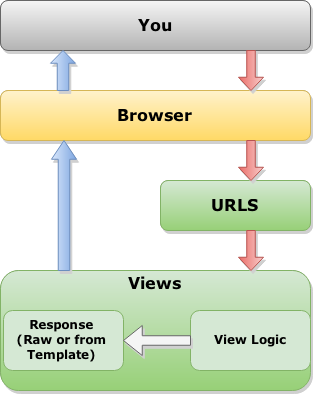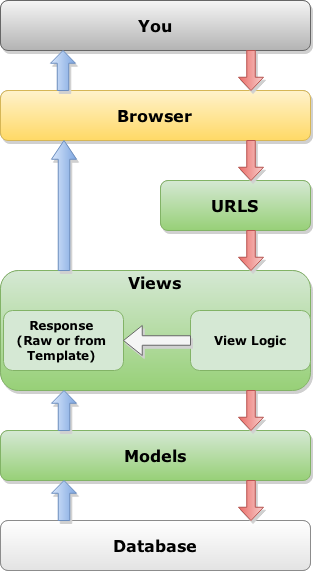Now we have a way to return templated pages that share some structure. Your server currently looks like this:
- A request comes in, and we try to match it to one of the patterns in
urls.py. - We find the matching view for that pattern in
views.pyand respond with some data that could be created from a template.
The next step is adding some way to save data. We want to be able to have user accounts, save tweets, etc and have that information saved when we restart the server. We can solve that using models in Django, turning our server into this:
You can think of a model as a declaration of some data that you want to store. Under the hood, Django will use a database to actually save that data, but it does all the heavy lifting so you don't have to worry about it.
We're going to be creating a fact model that lets us save random facts on our
website. First we have to configure some database settings so Django knows where
to store things. In buildup/settings.py add the following lines:
DATABASES = {
'default': {
'ENGINE': 'django.db.backends.sqlite3',
'NAME': os.path.join(BASE_DIR, 'buildup.db')
}
}
INSTALLED_APPS = (
'buildup',
)And now create the file buildup/models.py in your project.
from django.db import models
class Fact(models.Model):
text = models.CharField(max_length=255)
author = models.CharField(max_length=255)
created_date = models.DateTimeField('date created')We're declaring a model called Fact and saying that it should have text,
author, and created_date fields in it.
Now let's try saving some models! First we'll have to tell Django to create the database using this model definition. In your terminal type
python manage.py makemigrations buildup
python manage.py syncdbIf everything went correctly, you should see a buildup.db file in your project.
This is the database where all your information is stored.
Now let's try saving some data. We can experiment using the Django shell, which you can enter with
python manage.py shellThis is a special Python shell that has loaded Django and will let us experiment with models. First, let's import the model that we just created and some time utilties:
from buildup.models import Fact
from datetime import datetimeAnd now lets retrieve all the Facts that are stored in the database:
Fact.objects.all()What you get back is [], or an empty list - we haven't saved anything yet!
Let's try creating a model
f = Fact(text='Giraffes sleep standing up', author='Steve Irwin', created_date=datetime.now())Now you can access the fields of the model like so:
f.text
f.author
f.created_date
f.id
Django automatically adds a unique id field, which is used to track where this
model is stored in the database. Right now, the id is None because we haven't
saved the fact yet. After you run
f.save()the id should now be set to 1 (this is the first Fact we have saved). Now go
ahead and create and save some more facts. Once you have done so, we can try
retrieving all of the Facts again:
facts = Fact.objects.all()
print factsall returns a list of Facts, and you can access individual facts by "indexing".
Lists start with index 0, so if your list has 3 elements, index 0, 1, and 2 will
return the elements in order.
You can verify that the facts are correct by printing out the contents of each
one individually:
for fact in facts:
print fact.id, fact.text, fact.author, fact.created_dateWe can use for loops inside our templates too! Lets add a template that will
list all the facts in the database. In urls.py, add a pattern for /facts
called all_facts, and in views.py, import the Fact model and create the
all_facts function:
from buildup.models import Fact
# your other views.py code is here...
def all_facts(request):
return render(request, "all_facts.html", { "facts": Fact.objects.all() })Now add the corresponding template in buildup/templates/all_facts.html:
<html>
<head>
<title>Random Facts</title>
</head>
<body>
<h1>Random Facts</h1>
{% for fact in facts %}
<div>
<h3>{{ fact.text }}</h3>
- {{ fact.author }}, {{ fact.created_date }}
</div>
{% endfor %}
</body>
</html>Now when you add more facts in the shell, /facts will be updated on refresh!

